- Home
- Carl Sagan
Dragons of Eden Page 21
Dragons of Eden Read online
Page 21
HARNER, M. J., ed. Hallucinogens and Shamanism. Oxford University Press, London, 1973.
HARRIS, MARVIN. Cows, Pigs, Wars and Witches: The Riddles of Culture. Random House, New York, 1974.
HARTMANN, ERNEST L. The Functions of Sleep. Yale University Press, New Haven, Conn., 1973.
HAYES, C. The Ape in Our House. Harper, New York, 1951.
HERRICK, C. JUDSON. “A Sketch of the Origin of the Cerebral Hemispheres.” Journal of Comparative Neurology, Vol. 32, pp. 429–454, 1921.
HOLLOWAY, RALPH L. “Cranial Capacity and the Evolution of the Human Brain.” American Anthropologist, Vol. 68, pp. 103–121, 1966.
HOLLOWAY, RALPH L. “The Evolution of the Primate Brain: Some Aspects of Quantitative Relations.” Brain Research, Vol. 7, pp. 121–172, 1968.
HOWELL, F. CLARK. Early Man. Life Nature Library, Time, Inc., New York, 1965.
HOWELLS, WILLIAM. Mankind in the Making: The Story of Human Evolution. Rev. ed. Doubleday, New York, 1967.
HUBEL, D. H., and WIESEL, T. N. “Receptive Fields of Single Neurons in the Cat’s Striate Cortex.” Journal of Physiology, Vol. 150, pp. 91–104, 1960.
INGRAM, D. “Cerebral Speech Lateralization in Young Children.” Neuropsychologia, Vol. 13, pp. 103–105, 1975.
JERISON, H. J. Evolution of the Brain and Intelligence. Academic Press, New York, 1973.
JERISON, H. J. “The Theory of Encephalization.” Proceedings Conference on Evolution and Lateralization of the Brain, Annals of the New York Academy of Sciences, 1977.
KELLER, HELEN. The Story of My Life. New York, 1902.
KORSAKOV, S. “On the Psychology of Microcephalics [1893].” Reprinted in the American Journal of Mental Deficiency Research, Vol. 4, pp. 42–47, 1957.
KROEBER, T. Ishi in Two Worlds. University of California Press, Berkeley, 1961.
KURTEN, BJORN. Not from the Apes: The History of Man’s Origins and Evolution. Vintage Books, New York, 1972.
LA BARRE, WESTON. The Human Animal. University of Chicago Press, Chicago, 1954.
LANGER, SUSANNE. Philosophy in a New Key: A Study in the Symbolism of Reason, Rite and Art. Harvard University Press, Cambridge, Mass., 1942.
LASHLEY, K. S. “Persistent Problems in the Evolution of Mind.” Quarterly Review of Biology, Vol. 24, pp. 28–42, 1949.
LASHLEY, K. S. “In Search of the Engram.” Symposia of the Society of Experimental Biology, Vol. 4, pp. 454–482, 1950.
LEAKEY, RICHARD E. “Hominids in Africa.” American Scientist, Vol. 64, No. 2, p. 174, 1976.
LEAKEY, R. E. F., and A. C. WALKER. “Australopithecus, Homo erectus and the Single Species Hypothesis.” Nature, Vol. 261, pp. 572–574, 1976.
LEE, RICHARD, and IRVEN DEVORE, eds. Man, the Hunter. Aldine, Chicago, 1968.
LE MAY, M., and GESCHWIND, N. “Hemispheric Differences in the Brains of Great Apes.” Brain Behavior and Evolution. Vol. 11, pp. 48–52, 1975.
LETTVIN, J. Y., MATTURANA, H. R., MCCULLOCH, W. S., and PITTS, W. J. “What the Frog’s Eye Tells the Frog’s Brain.” Proceedings of the Institute of Radio Engineers, Vol. 47, pp. 1940–1951, 1959.
LIEBERMAN, P., KLATT, D., and W. H. WILSON. “Vocal Tract Limitations on the Vowel Repertoires of Rhesus Monkeys and Other Non-Human Primates.” Science, Vol. 164, pp. 1185–1187, 1969.
LINDEN, EUGENE. Apes, Men and Language. E. P. Dutton, New York, 1974.
LONGUET-HIGGINS, H. C. “Perception of Melodies.” Nature, Vol. 263, pp. 646–653, 1976.
MACLEAN, PAUL D. On the Evolution of Three Mentalities, to be published.
MACLEAN, PAUL, D. A Triune Concept of the Brain and Behaviour. University of Toronto Press, Toronto, 1973.
MCCULLOCH, W. S., and PITTS, W. “A Logical Calculus of the Ideas Immanent in Nervous Activity.” Bulletin of Mathematical Biophysics, Vol. 5, pp. 115–133, 1943.
MCHENRY, HENRY. “Fossils and the Mosaic Nature of Human Evolution.” Science, Vol. 190, pp. 425–431, 1975.
MEDDIS, RAY. “On the Function of Sleep.” Animal Behaviour, Vol. 23, pp. 676–691, 1975.
METTLER, F. A. Culture and the Structural Evolution of the Neural System. American Museum of Natural History, New York, 1956.
MILNER, BRENDA, CORKIN, SUZANNE and TEUBER, HANS-LUKAS. “Further Analysis of the Hippocampal Amnesic Syndrome: 14-Year Follow-up Study of H.M.” Neuropsychologia, Vol. 6, pp. 215–234, 1968.
MINSKY, MARVIN. “Artificial Intelligence.” Scientific American, Vol. 214, pp. 19–27, 1966.
MITTWOCH, URSULA. “Human Anatomy.” Nature, Vol. 261, p. 364, 1976.
NEBES, D., and R. W. SPERRY. “Hemispheric Deconnection Syndrome with Cerebral Birth Injury in the Dominant Arm Area.” Neuropsychologia, Vol. 9, pp. 247–259, 1971.
OXNARD, C. E. “The Place of the Australopithecines in Human Evolution: Grounds for Doubt?” Nature, Vol. 258, pp. 389–395, 1975.
PENFIELD, W., and T. C. Erickson. Epilepsy and Cerebral Localization. Charles C Thomas, Springfield, Ill., 1941.
PENFIELD, W., and L. ROBERTS. Speech and Brain Mechanisms. Princeton University Press, Princeton, N.J., 1959.
PILBEAM, DAVID. The Ascent of Man: An Introduction to Human Evolution. Macmillan, New York, 1972.
PILBEAM, D., and S. J. GOULD. “Size and Scaling in Human Evolution.” Science, Vol. 186, pp. 892–901, 1974.
PLATT, JOHN R. The Step to Man, John Wiley, New York, 1966.
PLOOG, D. W., BLITZ, I., and PLOOG, F. “Studies on Social and Sexual Behavior of the Squirrel Monkey (Saimari sciureus).” Folia Primatologica, Vol. 1, pp. 29–66, 1963.
POLIAKOV, G. I. Neuron Structure of the Brain. Harvard University Press, Cambridge, Mass., 1972.
PREMACK, DAVID. “Language and Intelligence in Ape and Man.” American Scientist, Vol. 64, pp. 674–683, 1976.
PRIBRAM, K. H. Languages of the Brain. Prentice-Hall, Englewood Cliffs, N.J., 1971.
RADINSKY, LEONARD. “Primate Brain Evolution.” American Scientist, Vol. 63, pp. 656–663, 1975.
RADINSKY, LEONARD. “Oldest Horse Brains: More Advanced than Previously Realized.” Science, Vol. 194, pp. 626–627, 1976.
RALL, W. “Theoretical Significance of Dendritic Trees for Neuronal Input-Output Relations.” In Neural Theory and Modeling, R. F. Reiss, ed., Stanford University Press, Stanford, 1964.
ROSE, STEVEN. The Conscious Brain. Alfred A. Knopf, New York, 1973.
ROSENZWEIG, MARK R., EDWARD L. BENNETT and MARIAN CLEEVES DIAMOND. “Brain Changes in Response to Experience.” Scientific American, Vol. 226, No. 2, pp. 22–29, February 1972.
RUMBAUGH, D. M., GILL, T. V., and E. C. VON GLASERFELD. “Reading and Sentence Completion by a Chimpanzee.” Science, Vol. 182, pp. 731–735, 1973.
RUSSELL, DALE A. “A New Specimen of Stenonychosaurus from the Oldman Formation (Cretaceous) of Alberta.” Canadian Journal of Earth Sciences, Vol. 6, pp. 595–612, 1969.
RUSSELL, DALE A. “Reptilian Diversity and the Cretaceous-Tertiary Transition in North America.” Geological Society of Canada Special Paper No. 13, pp. 119–136, 1973.
SAGAN, CARL. The Cosmic Connection: An Extraterrestrial Perspective. Doubleday, New York, 1973; and Dell, New York, 1975.
SAGAN, CARL, ed. Communication with Extraterrestrial Intelligence. MIT Press, Cambridge, Mass., 1973.
SCHMITT, FRANCIS O., PARVATI DEV, and BARRY H. SMITH. “Electrotonic Processing of Information by Brain Cells.” Science, Vol. 193, pp. 114–120, 1976.
SCHALLER, GEORGE. The Mountain Gorilla: Ecology and Behavior. University of Chicago Press, Chicago, 1963.
SCHANK, R. C., and K. M. COLBY, eds. Computer Models of Thought and Language. W. H. Freeman, San Francisco, 1973.
SHKLOVSKII, I. S., and CARL SAGAN. Intelligent Life in the Universe. Dell, New York, 1967.
SNYDER, F. “Toward an Evolutionary Theory of Dreaming.” American Journal of Psychiatry, Vol. 123, pp. 121–142, 1966.
SPERRY, R. W. “Perception in the Absence of the Neo-cortical Commissures.” In Perception and Its Disorders, Research Pu
blication of the Association for Research in Nervous and Mental Diseases, Vol. 48, 1970.
STAHL, BARBARA J. “Early and Recent Primitive Brain Forms.” Proceedings of the Conference on Evolution and Lateralization of the Brain, Annals of the New York Academy of Sciences, 1977.
SWANSON, CARL P. The Natural History of Man. Prentice-Hall, Englewood Cliffs, N.J., 1973.
TENG, EVELYN LEE, LEE, P. H., YANG, K.-S., and P. C. CHANG. “Handedness in a Chinese Population: Biological, Social and Pathological Factors.” Science, Vol. 193, pp. 1148–1150, 1976.
TEUBER, HANS-LUKAS. “Effects of Focal Brain Injury on Human Behavior.” In The Nervous System, Donald B. Tower, editor-in-chief, Vol. 2: The Clinical Neuro-sciences. Raven Press, New York, 1975.
TEUBER, HANS-LUKAS, MILNER, BRENDA, and VAUGHAN, H. G., JR. “Persistent Anterograde Amnesia after Stab Wound of the Basal Brain.” Neuropsychologia, Vol. 6, pp. 267–282, 1968.
TOWER, D. B. “Structural and Functional Organization of Mammalian Cerebral Cortex: The Correlation of Neurone Density with Brain Size.” Journal of Comparative Neurology, Vol. 101, pp. 19–51, 1954.
TROTTER, ROBERT J. “Language Evolving, Part II.” Science News, Vol. 108, pp. 378–383, 1975.
TROTTER, ROBERT J. “Sinister Psychology.” Science News, Vol. 106, pp. 220–222, October 5, 1974.
TURKEWITZ, GERALD. “The Development of Lateral Differentiation in the Human Infant.” Proceedings of the Conference on Evolution and Lateralization of the Brain, Annals of the New York Academy of Sciences, 1977.
VACROUX, A. “Microcomputers.” Scientific American, Vol. 232, pp. 32–40, May 1975.
VAN LAWICK-GOODALL, JANE. In the Shadow of Man. Houghton-Mifflin, Boston, 1971.
VAN VALEN, LEIGH. “Brain Size and Intelligence in Man.” American Journal of Physical Anthropology, Vol. 40, pp. 417–424, 1974.
VON NEUMANN, JOHN. The Computer and the Brain. Yale University Press, New Haven, Conn., 1958.
WALLACE, PATRICIA. “Unravelling the Mechanism of Memory.” Science, Vol. 190, pp. 1076–1078, 1975.
WARREN, J. M. “Possibly Unique Characteristics of Learning by Primates.” Journal of Human Evolution, Vol. 3, pp. 445–454, 1974.
WASHBURN, SHERWOOD L. “Tools and Human Evolution.” Scientific American, Vol. 203, pp. 62–75, September 1960.
WASHBURN, S. L., and R. MOORE. Ape Into Man. Little, Brown, Boston, 1974.
WEBB, W. B. Sleep, The Gentle Tyrant. Prentice-Hall, Englewood Cliffs, N.J., 1975.
WEIZENBAUM, JOSEPH. “Conversations with a Mechanical Psychiatrist.” The Harvard Review, Vol. 111, No. 2, pp. 68–73, 1965.
WENDT, HERBERT. In Search of Adam. Collier Books, New York, 1963.
WITELSON, S. F., and W. PALLIE. “Left Hemisphere Specialization for Language in the Newborn: Neuro-anatomical Evidence of Asymmetry.” Brain, Vol. 96, pp. 641–646, 1973.
YENI-KOMSHIAN, G. H., and D. A. BENSON. “Anatomical Study of Cerebral Asymmetry in the Temporal Lobe of Humans, Chimpanzees, and Rhesus Monkeys.” Science, Vol. 192, pp. 387–389, 1976.
YOUNG, J. Z. A Model of the Brain. Clarendon Press, Oxford, 1964.
Glossary
Accessing Computer jargon for making contact with information stored elsewhere.
AFFECT (noun) A feeling of emotion, particularly a strong one.
ALEXIA A weakening or loss of the ability to comprehend written or printed words and sentences. Compare with aphasia.
AMESLAN American sign language, widely used by persons with impaired speech and hearing.
AMYGDALA An almond-shaped component of the limbic system adjoining the temporal lobe of the neocortex.
ANAGLYPH A two-dimensional stereo representation of a three-dimensional image; most often composed of red and green dots, and viewed with red and green eye-glasses.
ANTERIOR COMMISSURE A relatively minor bundle of nerve fibers that connects the left and right cerebral hemispheres of the neocortex. Compare with corpus callosum.
APHASIA Generally, a weakening or loss of the ability to articulate ideas by language in any form. It is sometimes used more narrowly to indicate the inability to recognize spoken words. Compare with alexia.
BILATERAL On both sides.
BITS Units of binary information. One bit is the answer to a single yes or no question.
BRAINSTEM See Hindbrain.
BROCA’S AREA A portion of the neocortex intimately connected with speech.
BUFFER DUMPING The accessing (q.v.) or disposal of information temporarily deposited in a short-term memory.
CC Abbreviation for cubic centimeter.
CEREBELLUM A brain mass lying in the back of the head underneath the posterior cerebral cortex and above the pons and medulla in the hindbrain. Like the neocortex, it has two hemispheres.
CEREBRAL CORTEX In humans and higher mammals the large outer layer of the cerebral hemispheres, in major part responsible for our characteristically human behavior. Sometimes synonymous with neopallium or neocortex (q.v.).
CETACEA An order of aquatic mammals that includes whales and dolphins.
CHROMOSOMES The long strands of hereditary material containing the genes, and composed exclusively of nucleic acids.
CONVOLUTION See Gyrus.
CORPUS CALLOSUM The great commissure, or bundle of nerve fibers, which is the principal cabling between the left and right hemispheres of the cerebral cortex.
CRANIOTOMY The cutting or removal of part of the skull, generally as an antecedent to brain surgery.
DNA Deoxyribonucleic acid. See Nucleic acids.
ELECTRODE A solid electrical conductor through which an electric current moves. Electrical currents in the brain are sensed by an electroencephalograph through its electrodes.
ELECTROENCEPHALOGRAPH (EEG) A device consisting of amplifiers and a pen automatically writing on a rotating drum, used for recording the electrical currents in the brain conducted to the device by electrodes attached to the surface of the head. It is useful for medical diagnosis and for studies of the function of the brain.
ENDOCAST A mold of an interior; in this book, a mold of the interior of a fossil braincase.
ENDOCRANIAL Within the skull.
ENDORPHINS Small internally produced brain proteins which can induce a variety of emotional or other states in animals.
EQUIPOTENT Having equal ability; in particular, the view that for certain cognitive or other functions any part of the brain can substitute for any other.
EXTIRPATION The entire removal of a unit of the brain, usually by surgical procedures.
EXTRAGENETIC INFORMATION Information carried outside the genes—generally in brains and cultures.
EXTRASOMATIC INFORMATION Information carried outside the body (for example, the contents of books).
FOREBRAIN The evolutionarily most recent of the three major divisions of the vertebrate brain. Also called the prosencephalon. It is divided in turn into the R-complex, limbic system, and neocortex.
FRONTAL LOBE Approximately, the portion of the neocortex beneath the forehead.
GAMETES Mature sperm or egg cells capable of participating in fertilization. They contain a haploid (q.v.) number of chromosomes.
GYRUS One of the prominent rounded elevations on the surface of the neocortex. Also called convolution.
HAPLOID Having a number of chromosomes equal to half the number in an ordinary body or somatic cell. For example, in human beings each somatic cell has 46 chromosomes but each gamete (q.v.) has 23 chromosomes.
HINDBRAIN The most ancient part of the brain, including the pons, cerebellum, medulla oblongata, and the upper portion of the spinal cord. It is also called the brainstem or the rhombencephalon.
HIPPOCAMPAL COMMISSURE A relatively minor bundle of nerve fibers which connects the left and right hemispheres of the cerebral cortex near the hippocampus. Compare with corpus callosum.
HIPPOCAMPUS A structure in the limbic system connected with memory.
HYPOTHALAMUS A portion of the limbic system lying below
the thalamus which, among other functions, helps to regulate bodily temperature and metabolic processes.
KG Abbreviation for kilogram.
LATERALIZATION The separation of function between two sides, especially the left and right hemispheres of the neocortex.
LESION A cut, wound, or injury. Some brain lesions occur by accident and some by surgical procedure.
LIMBIC SYSTEMS The part of the forebrain intermediate in locale and antiquity between the R-complex and the neocortex.
LOBES OF THE NEOCORTEX See Frontal lobe, Occipital lobe, Parietal lobe, and Temporal lobe.
LOBOTOMY A surgical incision into or lesion of one of the neocortical lobes (q.v.).
LOCALIZATION OF BRAIN FUNCTION The finding that certain parts of the brain perform certain specific functions. It is the opposite of the equipotent (q.v.) hypothesis.
LONG-TERM MEMORY Memory retained for substantial periods of time—for example, more than a day.
M Abbreviation for meter.
MEDULLA OBLONGATA (sometimes called simply MEDULLA) The portion of the brain at the region of its connection with the spinal cord. It is a part of the hindbrain.
MICROCEPHALIC One with an abnormally small head. The condition is often associated with significant mental impairment.
MIDBRAIN The middle region of the vertebrate brain, between the hindbrain and forebrain. Also called the mesencephalon.
MOTOR CORTEX The portion of the neocortex concerned with motion and coordination of the limbs.
MUTATIONS Inheritable changes in the nucleic acids of chromosomes.
NATURAL SELECTION The principal method of biological evolution, as first described by Darwin and Wallace. The preferential survival and reproduction of organisms fortuitously better adapted to their environments than their competitors.
NEOCORTEX The outermost, evolutionarily most recent part of the cerebral cortex. Sometimes used as synonymous with cerebral cortex.
NEURAL CHASSIS The combination of spinal cord, hind-brain, and midbrain.
NEURON or NEURONE A nerve cell, the basic unit of the nervous system, and the fundamental building block of the brain.
NICHE, ECOLOGICAL An organism’s role in nature.
NUCLEIC ACIDS The genetic material of all life on Earth, consisting of ladder-like sequences of units called nucleotides, usually arranged in a double helix. There are two main varieties of nucleic acids, DNA and RNA.

 Cosmos
Cosmos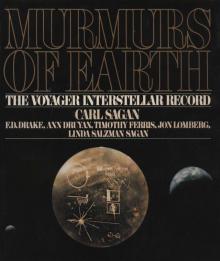 Murmurs of Earth
Murmurs of Earth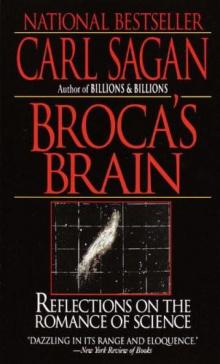 Broca's Brain
Broca's Brain Comet
Comet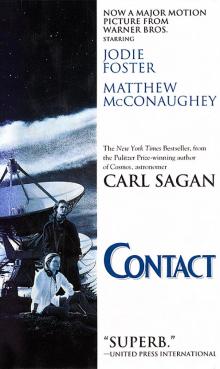 Contact
Contact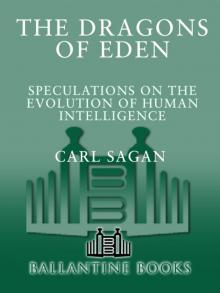 Dragons of Eden
Dragons of Eden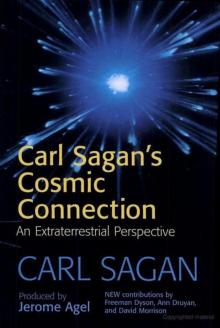 Cosmic Connection
Cosmic Connection Shadows of Forgotten Ancestors
Shadows of Forgotten Ancestors Billions & Billions
Billions & Billions Comet, Revised
Comet, Revised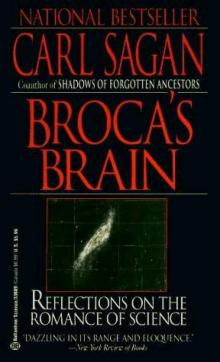 Broca's Brain: The Romance of Science
Broca's Brain: The Romance of Science The Varieties of Scientific Experience: A Personal View of the Search for God
The Varieties of Scientific Experience: A Personal View of the Search for God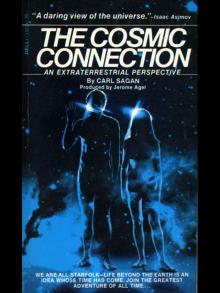 The Cosmic Connection
The Cosmic Connection Pale Blue Dot: A Vision of the Human Future in Space
Pale Blue Dot: A Vision of the Human Future in Space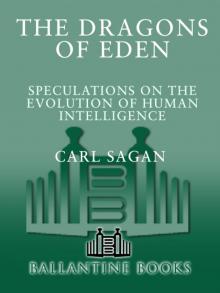 The Dragons of Eden
The Dragons of Eden